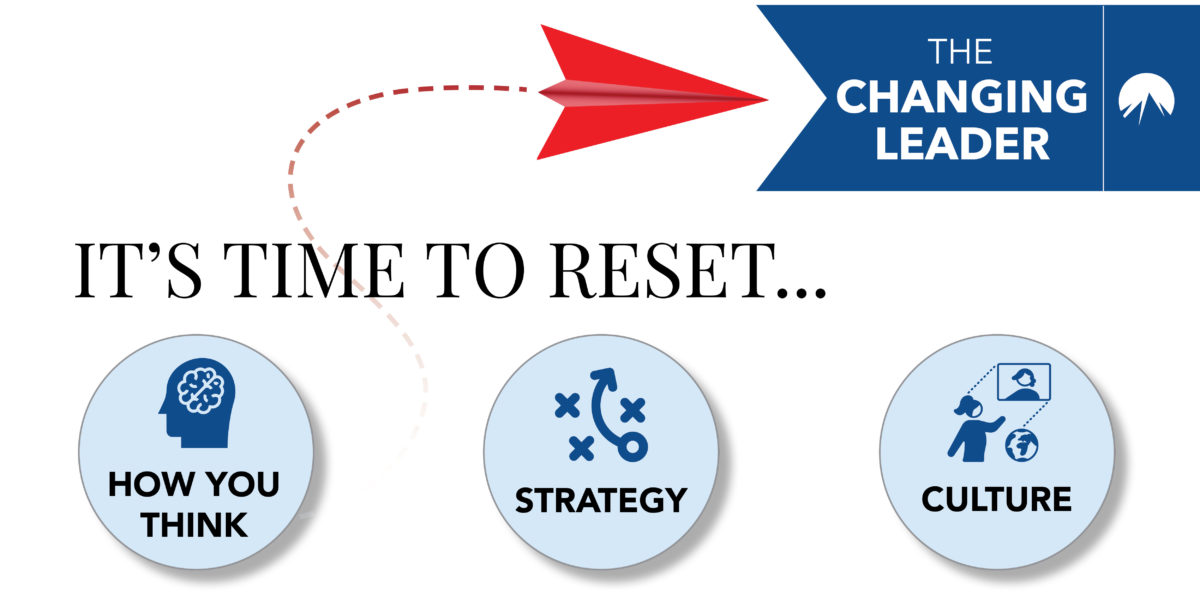We are halfway through the year and so much has changed in such a short period of time.
In the Boulder and Denver, Colorado areas, we are now in our fourth full month of learning how to live with COVID-19.
As I reflect on these past four months, I’ve heard many people describe this period as a pause.
I believe this period is better described as a reset.
We aren’t going back to the way things were, and as we approach the end of Q2, this is the perfect time to consider the current state of your business and the gap between where it is and your original aspirations for the year.
We have an opportunity to reset the future of work through our thinking, strategy and culture.
Reset How You Think
One of the fundamental questions I ask in my Future of Leadership podcast is this: Who will leaders need to be to succeed in the future?
Part of that answer lies in how leaders think.
In the words of Einstein, “We can’t solve problems by using the same kind of thinking we used when we created them.”
Our thinking will need to shift in order for us to be successful – primarily because most of the problems we had to solve in the past had a high level of predictability to them. When an event occurs, we could look at similar events of the past or tap into experts with a playbook and decide on a course of action.
Today, the level of complexity, the pace of change and cultural shifts make problem-solving less predictable. Cause and effect can only be deduced after the fact, and the courses of action to take are not clear. In this environment, leaders have to learn how to first experiment, look for patterns and then apply learnings. They also have to let go of power and control, embracing emergent level of thinking from diverse perspectives.
Once we reset how we think about today’s challenges, we can take on the important work of resetting strategy.
Reset Your Strategy
Business conditions have changed dramatically since January, and the strategic priorities you defined at the beginning of 2020 may now be temporarily or permanently obsolete.
For most businesses, it’s time to make new choices – choices about what to do and choices about what not to so.
Here are three steps to help reset your strategy so that you can be prepared to thrive in the second half of 2020.
STEP 1: Understand your current state.
Take an inventory of where the business is today. A simple SWOT analysis can help.
● What are your internal strengths?
● What are your internal weaknesses?
● What external opportunities exist?
● What external threats should the business be focused on?
The SWOT that you completed in January of 2020 likely looks very different than today. Under stress, weaknesses and threats are magnified while strengths and opportunities are harder to see.
STEP 2: Observe the recent patterns.
Henry Mintzberg, a professor, author and researcher on management theory, described what he called emergent strategy. An emergent strategy is a pattern of action that develops over time in an organization as original plans collide with and accommodate a changing reality. In other words, our strategy emerges informally as we react and respond to market conditions. An emergent strategy happens less formally and deliberately and can emerge from any level within an organization.
What have you observed about how your organization has responded in the last 60-90 days?
How does that inform a go-forward strategy?
STEP 3: Revisit the critical strategic planning questions.
Now that you’ve taken time to consider your current state and observe emerging patterns, you can now address the critical questions we outlined in alluded to in January 2020 blog post, Strategic Planning Stops the Pretending and Guessing. These questions were developed by Roger Martin in his 2013 book Playing to Win:
1. What is our winning aspiration?
2. Where will we play?
3. How will we win where we have chosen to play?
4. What capabilities must be in place to win?
5. What management systems are required to ensure the capabilities are in place?
As Roger mentioned, making strategy choices is never easy, because it is always at the expense of other choices.
What new choices will your organization make today?
Reset Your Culture
No matter how you define it, organizational culture has faced dramatic – likely permanent – changes in the wake of COVID-19. Abrupt transitions to remote work are forcing new modes of communication. Rebuilt business strategies have no guarantees of success. There is an ever-present need for a workforce to do more with less. Now more than ever, culture matters and organizations must face the very real choice between actively shaping a culture that supports business recovery or letting culture emerge in a way that drags down morale, collaboration and performance.
We know that interpersonal agility, first defined in my book Unite! The 4 Mindset Shifts for Senior Leaders, team agility and leadership agility will both play a role in helping organizations adapt to the unpredictability and complexity in our workplace.
● What values matter most to the organization now?
● What new behaviors are expected of your people?
● What will people need to do to be successful in this new normal?
● What personal traits will become more important in our future work?
● How can you bring more humanity into the workplace?
Your Business Re-prioritization Toolkit
We are in the middle of winter right now.
Unfortunately, not all companies will emerge from the storms that we currently face.
But those who reset how they think, their business strategy and culture will plant the seeds for growth in the new season.
We invite you to download our Business Re-prioritization Toolkit below. This practical framework will help you reset your thinking, strategy and culture so that you can emerge from this crisis stronger than ever.

